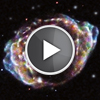CXC Home | Search | Help | Image Use Policy | Latest Images | Privacy | Accessibility | Glossary | Q&A
Tour of G1.9+0.3
Quicktime MPEG With closed-captions (at YouTube)
Astronomers estimate that a star explodes as a supernova in our Galaxy, on average, about twice per century. In 2008, a team of scientists announced they discovered the remains of a supernova that is the most recent, in Earth's time frame, known to have occurred in the Milky Way. The explosion would have been visible from Earth a little more than a hundred years ago, if it hadn't been heavily obscured by dust and gas. Today, that object is known as the supernova G1.9+0.3 or G1.9 for short. A new long observation -- equivalent to more than 11 days of Chandra time -- of explosion's debris field is providing new details about G1.9. The source of G1.9 was most likely a white dwarf star that underwent a thermonuclear detonation and was destroyed - either after merging with another white dwarf or by pulling too much material from an orbiting companion star. The explosion ejected the remains of the destroyed star, creating the supernova remnant seen today by Chandra and other telescopes. The new Chandra data show that the explosion that created G1.9 was different than other supernovas like it. For starters, the remnant's debris is unevenly distributed, while most other supernova remnant are highly symmetrical. Also, researchers found that some of the debris - particularly iron that would have been in the star's core before the explosion -- is moving at extremely high speeds. By combining these clues from the Chandra data with theoretical models, scientists think that the explosion that created G1.9 must have been highly irregular and abnormally energetic.
[Runtime: 01:56]
Quicktime MPEG With closed-captions (at YouTube)
Astronomers estimate that a star explodes as a supernova in our Galaxy, on average, about twice per century. In 2008, a team of scientists announced they discovered the remains of a supernova that is the most recent, in Earth's time frame, known to have occurred in the Milky Way. The explosion would have been visible from Earth a little more than a hundred years ago, if it hadn't been heavily obscured by dust and gas. Today, that object is known as the supernova G1.9+0.3 or G1.9 for short. A new long observation -- equivalent to more than 11 days of Chandra time -- of explosion's debris field is providing new details about G1.9. The source of G1.9 was most likely a white dwarf star that underwent a thermonuclear detonation and was destroyed - either after merging with another white dwarf or by pulling too much material from an orbiting companion star. The explosion ejected the remains of the destroyed star, creating the supernova remnant seen today by Chandra and other telescopes. The new Chandra data show that the explosion that created G1.9 was different than other supernovas like it. For starters, the remnant's debris is unevenly distributed, while most other supernova remnant are highly symmetrical. Also, researchers found that some of the debris - particularly iron that would have been in the star's core before the explosion -- is moving at extremely high speeds. By combining these clues from the Chandra data with theoretical models, scientists think that the explosion that created G1.9 must have been highly irregular and abnormally energetic.
[Runtime: 01:56]
(Credit: NASA/CXC/J. DePasquale)
The Big Explosion No One Saw
Quicktime MPEG With closed-captions (at YouTube)
About once or twice every 100 years, a gigantic nuclear bomb detonates in our Galaxy. In just a few short weeks, it blasts out as much energy as our Sun will in its entire lifetime! This powerful explosion is called a 'supernova', and it is the result of a star dramatically ending its life.
The most recent supernova in our galaxy, the Milky Way, happened just over 100 years ago. But, unfortunately for our great-great-great grandparents, the explosion was hidden behind thick clouds of gas and cosmic dust, far away from the Earth. So they couldn't witness this very rare sight. Because of this cosmic dust, it wasn't until 2008 that a group of astronomers finally stumbled upon the remains of the obliterated star, which you can see in this photograph.
Normally, when a supernova like this happens, the star's material is blown out evenly in all directions. This leaves behind a cloud that is more or less neat and symmetrical, but the object in this picture doesn't follow a neat pattern. Most of the star's material was blasted towards the top of the picture, and it's still travelling in that direction extremely fast. From these clues, astronomers have deduced that this must have been an unusually energetic and messy supernova explosion!
As far as we know, the last supernova in the Milky Way was over 100 years ago. If they happen on average every 100 years or so, another one should be due really soon. Keep your eyes on the skies and you might be the one to spot it first!
[Runtime: 02:05]
Quicktime MPEG With closed-captions (at YouTube)
About once or twice every 100 years, a gigantic nuclear bomb detonates in our Galaxy. In just a few short weeks, it blasts out as much energy as our Sun will in its entire lifetime! This powerful explosion is called a 'supernova', and it is the result of a star dramatically ending its life.
The most recent supernova in our galaxy, the Milky Way, happened just over 100 years ago. But, unfortunately for our great-great-great grandparents, the explosion was hidden behind thick clouds of gas and cosmic dust, far away from the Earth. So they couldn't witness this very rare sight. Because of this cosmic dust, it wasn't until 2008 that a group of astronomers finally stumbled upon the remains of the obliterated star, which you can see in this photograph.
Normally, when a supernova like this happens, the star's material is blown out evenly in all directions. This leaves behind a cloud that is more or less neat and symmetrical, but the object in this picture doesn't follow a neat pattern. Most of the star's material was blasted towards the top of the picture, and it's still travelling in that direction extremely fast. From these clues, astronomers have deduced that this must have been an unusually energetic and messy supernova explosion!
As far as we know, the last supernova in the Milky Way was over 100 years ago. If they happen on average every 100 years or so, another one should be due really soon. Keep your eyes on the skies and you might be the one to spot it first!
[Runtime: 02:05]
(Credit: NASA/CXC/April Jubett)
Return to G1.9+0.3 (June 26, 2013)




